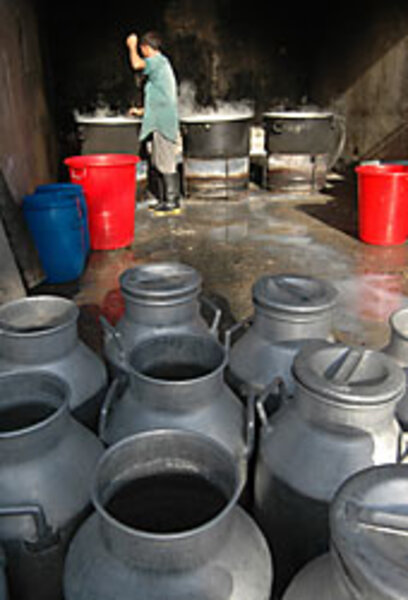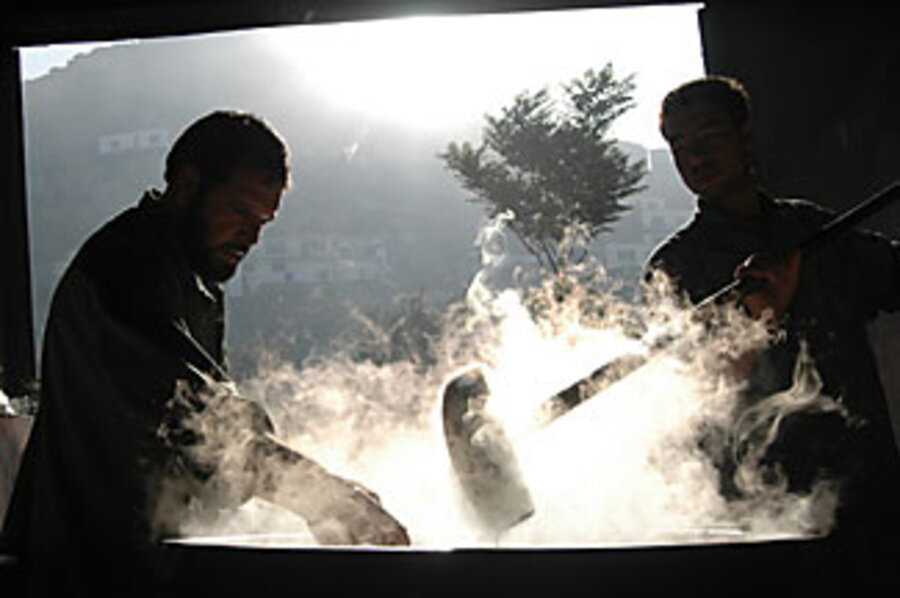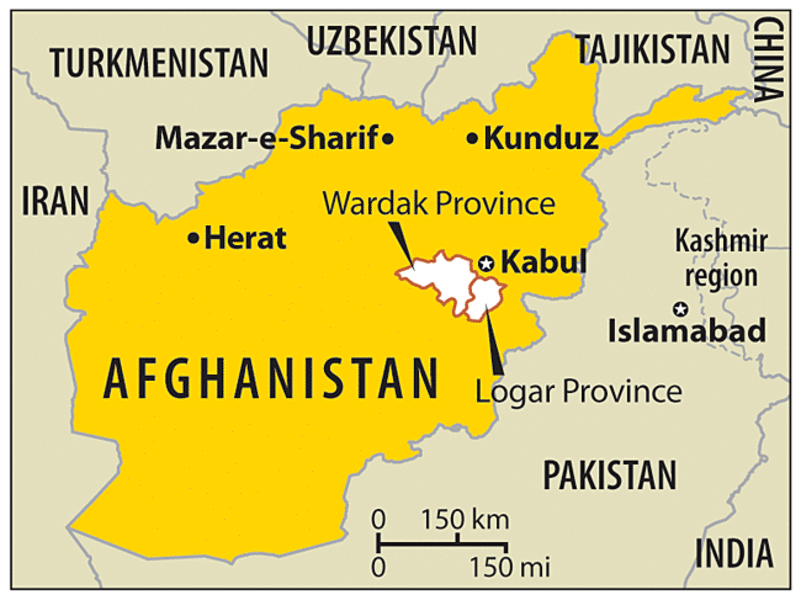Afghans find modest prosperity in once-banned trade – milk
Loading...
| KABUL, AFGHANISTAN
Zakaria Ahmadzai's dream of saving thousands of Afghans from war and poverty sounds a bit far-fetched at first.
He wants to revolutionize Afghanistan's dairy industry, creating as many as 100,000 jobs. It is an ambitious plan, considering that the industry essentially did not exist seven years ago, and that back then Mr. Ahmadzai was a manual laborer earning $3 a day.
But the nascent dairy trade has made entrepreneurs of men like Ahmadzai, now head of Afghanistan's first dairy cooperative. His income has doubled since he began selling milk from his three cows – a practice once forbidden by the Taliban. Other dairy farmers' salaries have increased 10-fold since 2002 to about $545 – more than twice the average yearly income here.
To Ahmadzai, it demonstrates how – with international help – Afghans can find alternatives to opium or insurgency.
"This changes the life of our people," he says. "If they can have money easily with peace, why do they need to fight?"
The Afghan economy is growing at double-digit rates – 13.5 percent during the past year, according to the World Bank. At the same time, billions of dollars of foreign aid is pouring into the country. Yet neither the economic growth nor the aid is having a substantial impact on the lives of ordinary Afghans, 85 percent of whom make a living in agriculture.
A wide array of aid projects has targeted agriculture – from pistachio growers in the north to pomegranate farmers in the south. Some have had success, many have not – for a variety of reasons, ranging from a reluctance among aid organizations to work beyond secure compounds in Kabul to an unwillingness to embark on long-term projects.
Incomes jump fivefold
The United Nations Food and Agriculture Organization's (UNFAO) dairy scheme, which began in 2001, has required no small amount of patience, persuasion, and creativity. But the result has been Ahmadzai's Kabul Dairy Union, a cooperative of 620 local farmers established in 2006 that runs its own affairs and covers its own expenses.
The project's success has been in its simplicity, says the UNFAO's Mustafa Zafar. Afghan farmers generally keep one or two cows for family use, and the goal was to teach farmers how to leverage those cows into a better life, he explains.
For Ghulam Sediq, it has worked. Like Ahmadzai, he used to make his living as a day laborer, filling trenches with sand for construction projects. The work was hard and the pay meager. "Feeding my eight children was very, very difficult," he says.
Now, with his five cows, Mr. Sediq makes $20 a day – five times what he made as a laborer. "With that, I can take care of my family easily – feeding them and buying them good clothes," he says. "And it's not a lot of work."
One of the cooperative's collectors, Mohammad Hanif, still runs a butcher shop on the side. With the extra money from selling milk from his two cows and collecting the milk from Logar Province, he built a $15,000 house – making him rich by his village's standards, he says with a wide smile. Now he wants to buy more cows.
"It's a big difference, because people are making legal money," says Khair Mohammad, an assistant at the Kabul Dairy Union.
Speaking generally, he adds: "If these farmers didn't have this, they would be growing poppy."
Based on its success in Kabul, UNFAO has established two more cooperatives in the northern cities of Kunduz and Mazar-e-Sharif. The Italian Provincial Reconstruction Team in the western city of Herat is planning a fourth.
From family cows to dairy coop
To get to this point has required countless conversations to build trust. The notion of an Afghan dairy farmer, curious to outsiders, was no less curious to Afghans themselves at first.
"Afghan farmers told us: 'This is not our culture,' " says Dr. Zafar.
It took a year of preliminary work to convince them. Part of this was training farmers how better to care for their cows, increasing yields. But part of it became a debate on Islamic doctrine. In 2001, the Taliban had opposed the scheme on the grounds that milk was the food of heaven and should not be sold.
Even after the Taliban left, collector Mr. Hanif remembers when farmers used to bring their milk to him hidden beneath their vests, embarrassed. Now he points to the dozens of canisters lined up on the slick white tiles of the Kabul Dairy Union's receiving dock. Eventually, logic won out.
Farmers milk their cows three times a day. Their families cannot drink all of it, meaning the rest is given to the poor or left to go sour.
"You have to throw milk away," Mr. Hanif recalls a member of the UNFAO project telling him. "Why not sell it?"
Zafar and Ahmadzai built the Kabul Dairy Union on this simple principle.
Still needed: storage, safe passage
There are numerous challenges. No farmers say they have been harassed by the Taliban for selling milk, but Taliban fighters confiscated one of the cooperative's two trucks about a month ago because it had UN license plates. The cooperative has had to rent another for $60 a day.
Perhaps a bigger problem, though, is that police at checkpoints routinely demand bribes, says Hanif. "They ask for milk, but we don't give it to them, because if you give it to them, they will start asking for more milk every day," he says, adding that they have to pay $3 to $4 instead.
Despite this, Ahmadzai has been able to build a modest operation – two rooms filled with shiny silver equipment donated by Germany that spins, whirrs, and clatters in the background, separating the raw milk into milk, yogurt, cheese, and butter.
In a country with virtually no refrigeration outside Kabul, farmers at collection points keep milk cool by draping canisters with wet rags or immersing them in pools of water.
Still, a bootstrap mentality can only take the cooperative so far, says Ahmadzai. Without cold storage at collection points, the cooperative can operate only in two neighboring provinces, Logar and Wardak. Moreover, it can make only one collection a day, cutting potential profits by two-thirds.
Ahmadzai imagines foreign donors helping to build cold-storage centers across the country. With more advanced equipment that packages milk to stay good for weeks without refrigeration, he says, Afghanistan could employ thousands of people and lessen its reliance on imports. Currently, the Kabul Dairy Union supplies less than 1 percent of the Kabul dairy market.
There are four million people in Kabul who need to purchase dairy products," he says, noting that people in the capital don't have their own cows. "We have a market."








